Continued from part one
(Edit April 2016: Follow along with Google’s “street view” of the Nose!)
Standing at the bottom of El Cap is pretty intimidating. Hell, sitting in El Cap Meadow, half a mile away, and staring up at the wall is pretty intimidating. It is an immense piece of stone. In the Meadow, if you look straight above you, then slowly tilt your head forward until you are at the horizon line, El Cap takes up about 70% of that space. It is the biggest piece of rock most anyone attempting to climb it has ever seen.
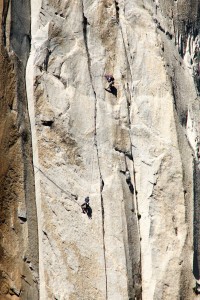
Lowering out in the Stovelegs.
Photo by Tom Evans
And there we were, on the morning of May 23rd, gazing up the wall. We had 5 gallon jugs of water and 4 days of food in the bag (firmly secured 400′ above), along with sleeping gear, warm clothes and bare cooking supplies. It was time to commit. I was amped.
We quickly jugged up the multiple fixed lines, the last of which we had fixed ourselves (in case someone took it down while we were at the base), and were at a happily barren Sickle Ledge within an hour. It was Eric’s block to lead, so I hunkered down with my GriGri and watched him take off free-climbing the gradually steepening corner above. We linked the two pitches (5 and 6) and I started a combination of jugging and free-climbing, as the terrain was quite low-angle. Eric hauled while I tended the pig, freeing it from the occasional constriction while he pulled from above (and to the right). At some point I had to lower-out the bag with a 50′ thin line we had brought along for just this purpose.
The Nose is probably not the best wall for the aspiring Wall Climber. It has quite a bit of traversing, which normally isn’t a big deal, but quickly becomes logistically difficult when you’re so dependent on vertically-oriented ropes. Haul bags must be lowered out so that they don’t cut loose and swing violently, smashing your water jugs and other stuff in the pack. When jugging (ascending the rope with mechanical devices), you have to lower yourself out for similar reasons. I’ll leave the detailed instructions out of this post, but suffice it to say we had done substantial research and a bit of practice to figure out these techniques, and still learned the majority of it on-route.
We made pretty quick work through the Stovelegs — Eric performed the first pendulum of the climb, a fun one where you had to jump over a 2-3 foot corner in the middle of each swing. After pitch 10 or so, he was utterly exhausted from all the hauling (the leader has to haul too) so I took over the lead. He had just aided an amazing-looking 5.9 hand crack which seemed like a bit of a shame, so I freed about half of the next pitch before things got wide. Here I ended up bumping a #4 for probably 60 feet, then bumping a 170° tipped-out #3 the rest of the way. (Two #4s are nice here!) After a long pitch I emerged on top of Dolt Tower, our planned first bivy. Hauling was extremely strenuous and I soon had much more compassion for Eric’s state — he had dragged that thing up five pitches!
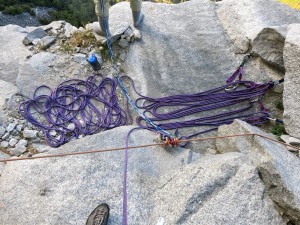
My “mattress pad”. Notice the orange fixed line in the foreground, for staying clipped into while sleeping
Most parties don’t bother with a portaledge on the Nose due to the quantity (and quality!) of good, natural bivy ledges on the route. Our original plan was to sleep at El Cap Tower (p15) and Camp 5 (p25), climbing the route in three days. It became clear pretty quickly that this was a bit ambitious. Fortunately, we had supplies to last 4 days, and could probably stretch them to five if necessary.
We had topped out right before dark, and were pretty psyched to have had such a great day of climbing covering so much stone. We busted out the dried mashed potatoes, (pre-cooked) sausages and cheese and had ourselves a tasty feast while soaking in our surroundings. We had also squeezed 4 King Cobras into the pack, one for each of us at each bivy, so we relaxed for a bit sipping suds (Worth the weight? Hell ya!) It was pretty majestic to be hanging out in such a cool location, with great weather and relative comfort. Our friend Joe, who we had shared a site at Camp 4 with for a couple days, was soloing Zodiac at the time, so we scanned the wall to the East to see if we could see him. There seemed to a couple parties on the route so it was hard to pick him out, but sure enough, he ended up topping out a few days later!
I had neglected to bring a mattress pad, since I didn’t really own one that was small enough to jam into our haul bag. So I made one from the tag line. It wasn’t very comfortable. Luckily, you are so exhausted it doesn’t really matter. We slept soundly until being wakened by the sun peeking out over Half Dome in the morning.
Continued in Part Three
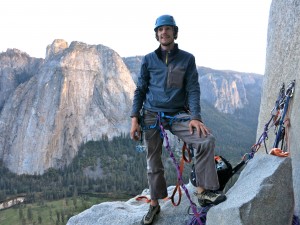
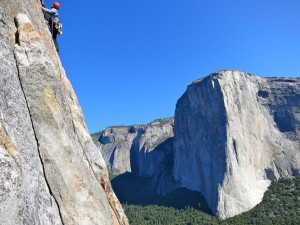
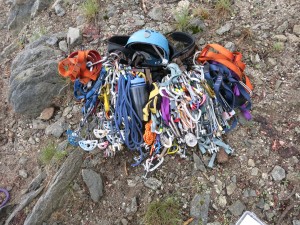
Recent Comments